Joint high-dimensional Bayesian variable and covariance selection with an application to eQTL analysis
January 26, 2012
2:30 p.m.
Anindya Bhadra
Abstract
Abstract: We describe a Bayesian technique to (a) perform a sparse joint selection of significant predictor variables and significant inverse covariance matrix elements of the response variables in a high-dimensional linear Gaussian sparse seemingly unrelated regression (SSUR) setting and (b) perform an association analysis between the high-dimensional sets of predictors and responses in such a setting. To search the high-dimensional model space, where both the number of predictors and the number of possibly correlated responses can be larger than the sample size, we demonstrate that a marginalization-based collapsed Gibbs sampler, in combination with spike and slab type of priors, offers a computationally feasible and efficient solution. As an example, we apply our method to an expression quantitative trait loci (eQTL) analysis on publicly available single neucleotide polymorphism (SNP) and gene expression data for humans where the primary interest lies in finding the significant associations between the sets of SNPs and possibly correlated genetic transcripts. Our method also allows for inference on the sparse regulatory network of the transcripts (response variables) after accounting for the effect of the SNPs (predictor variables). We exploit properties of Gaussian graphical models to make statements concerning conditional independence of the responses. Joint work with Bani K. Mallick.

